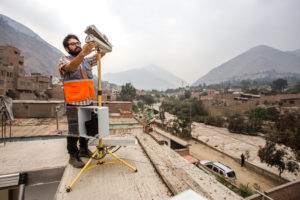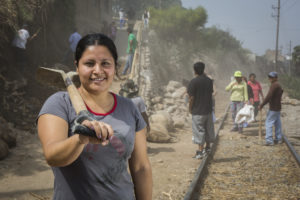193.4 million people were affected by disasters related to natural hazards every year from 2001 to 2020. It can cost billions of pounds to rebuild homes, businesses, towns and lives after such events, not to mention the psychological cost of trauma and losing loved ones. And as the climate crisis worsens, more communities are likely to become vulnerable to natural hazards like floods, storms and landslides.
It sounds bleak, but there is good news out there. Practical Action staff have been making good progress to better understand and predict extreme weather-related events. As the Science for Humanitarian Emergencies and Resilience programme (SHEAR) comes to a close, we reflect on its achievements and what this means for at-risk communities on the ground.
Around the world practitioners, academics and disaster risk and resilience specialists are developing the knowledge and tools needed to mitigate the risks posed by natural disasters. But all too often, a lack of knowledge sharing and communication between agencies and institutions can prevent such advances being maximised or reaching the necessary people in high-risk zones.
 Practical Action colleagues working on the SHEAR programme united several multi-disciplinary partners through a range of projects to further research in forecasting and early warning systems on a global scale. A key element of the SHEAR programme has been a bridging of the potential divide between science and practise, as well as the dissemination of knowledge in relevant, accessible formats to those who need it to act. Practical Action played a vital role as knowledge brokers, together with the Red Cross Red Crescent Climate Centre. We ensured that new research was captured, synthesized and translated into appropriate languages and actionable formats. We then disseminated this knowledge to relevant practitioners and decision makers to make sure it was deployed and of benefit to people at risk of natural hazards.
Practical Action colleagues working on the SHEAR programme united several multi-disciplinary partners through a range of projects to further research in forecasting and early warning systems on a global scale. A key element of the SHEAR programme has been a bridging of the potential divide between science and practise, as well as the dissemination of knowledge in relevant, accessible formats to those who need it to act. Practical Action played a vital role as knowledge brokers, together with the Red Cross Red Crescent Climate Centre. We ensured that new research was captured, synthesized and translated into appropriate languages and actionable formats. We then disseminated this knowledge to relevant practitioners and decision makers to make sure it was deployed and of benefit to people at risk of natural hazards.
Impact
The SHEAR programme made scientific advances in understanding hazard risk, developing forecasting methods and early warning systems for both fast- and slow-onset hazards, and developing early-action knowledge for the use of decision makers and local authorities. This progress is vital for informing effective disaster preparedness and response. The information and insights gained through these diverse projects have been applied, shared and put into the hands of those who need it on the ground.
In Kenya, government agencies are now confidently utilising advanced operational forecasting systems to predict drought, thanks to the SHEAR programme. This vital forecast information is helping farmers to plan and prepare for dry conditions. Meanwhile in Mozambique, when Cyclone Idai and Kennet hit in 2019, information could be sent to humanitarian organisations in time to save lives, thanks to the real-time emergency flood information systems established by SHEAR partners.
Forecasting landslides has been a major part of the project. 4.8 million people were affected by landslides across the globe between 1998 and 2017, including 18,000 fatalities. Yet very few countries have effective, functioning early-warning systems in place, even at a regional level.
 Through the LANDSLIP project, Practical Action partnered with researchers and practitioners to improve prediction and forecasting systems, focusing particularly on India and Nepal. For example, in the Nilgiris and Darjeeling regions of India, a prototype regional early warning system for landslides was developed which emits daily forecast bulletins to government officials, therefore directly improving the resilience of at-risk communities.
Through the LANDSLIP project, Practical Action partnered with researchers and practitioners to improve prediction and forecasting systems, focusing particularly on India and Nepal. For example, in the Nilgiris and Darjeeling regions of India, a prototype regional early warning system for landslides was developed which emits daily forecast bulletins to government officials, therefore directly improving the resilience of at-risk communities.
The fantastic work of the LANDSLIP project is also being continued by the Geological Survey of India, who have now established a landslide forecasting centre as a result of their participation. Their aim to develop similar landslide early warning systems in other parts of India by 2030, providing crucial information to authorities to mitigate risk.
You can explore some of the knowledge captured through the SHEAR programme and our work on landslide early warning systems in our Knowledge Centre here.